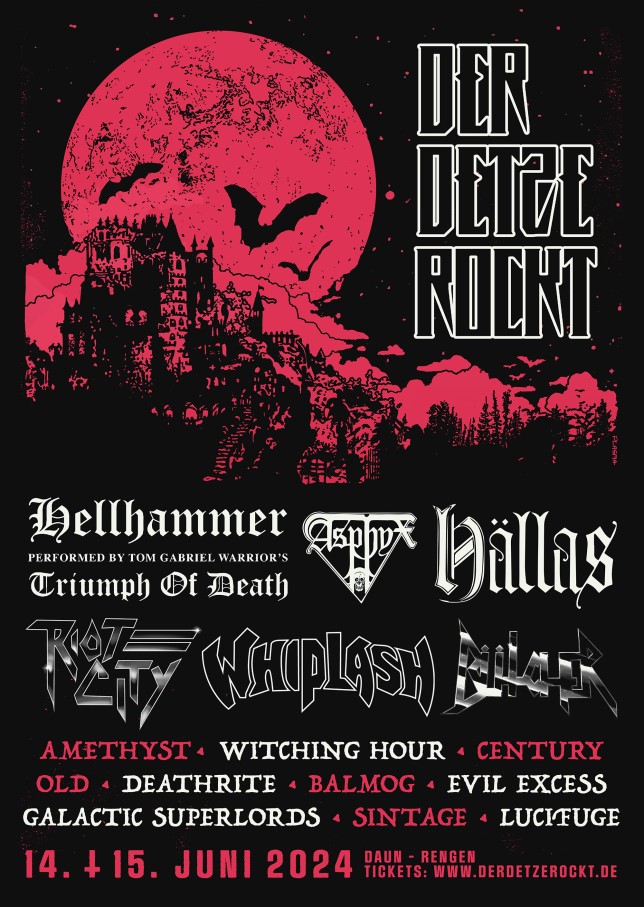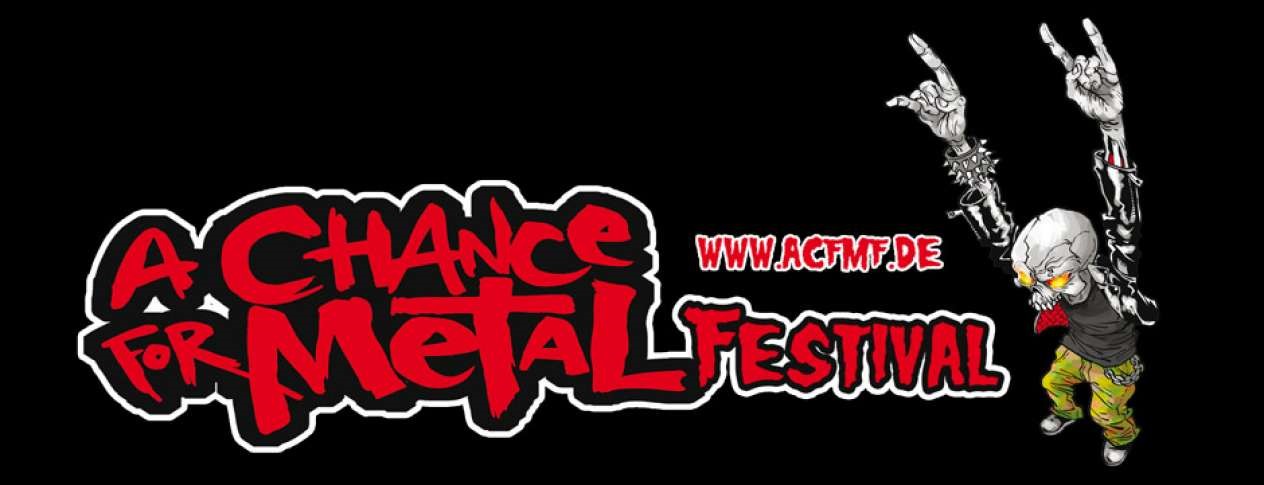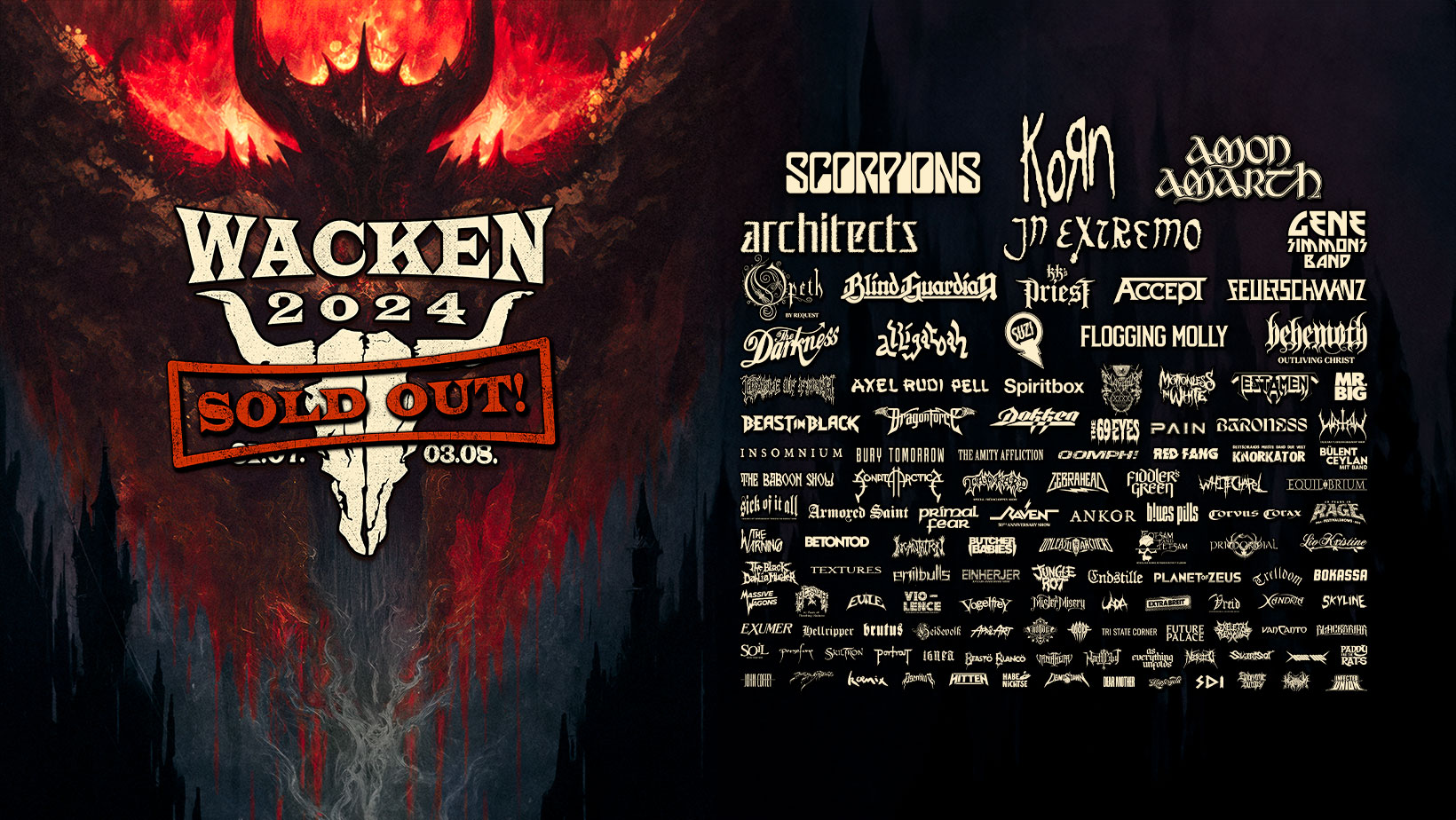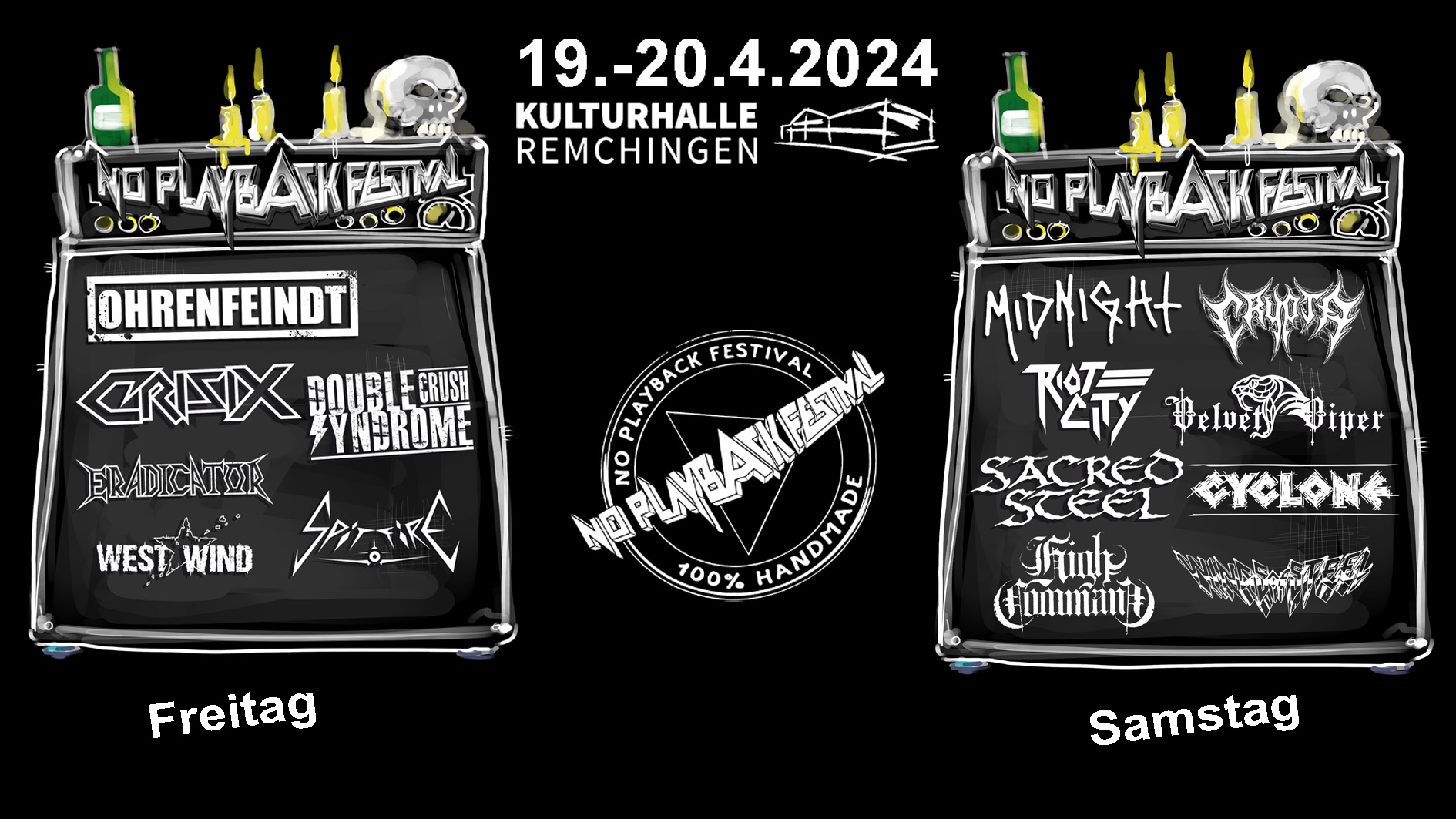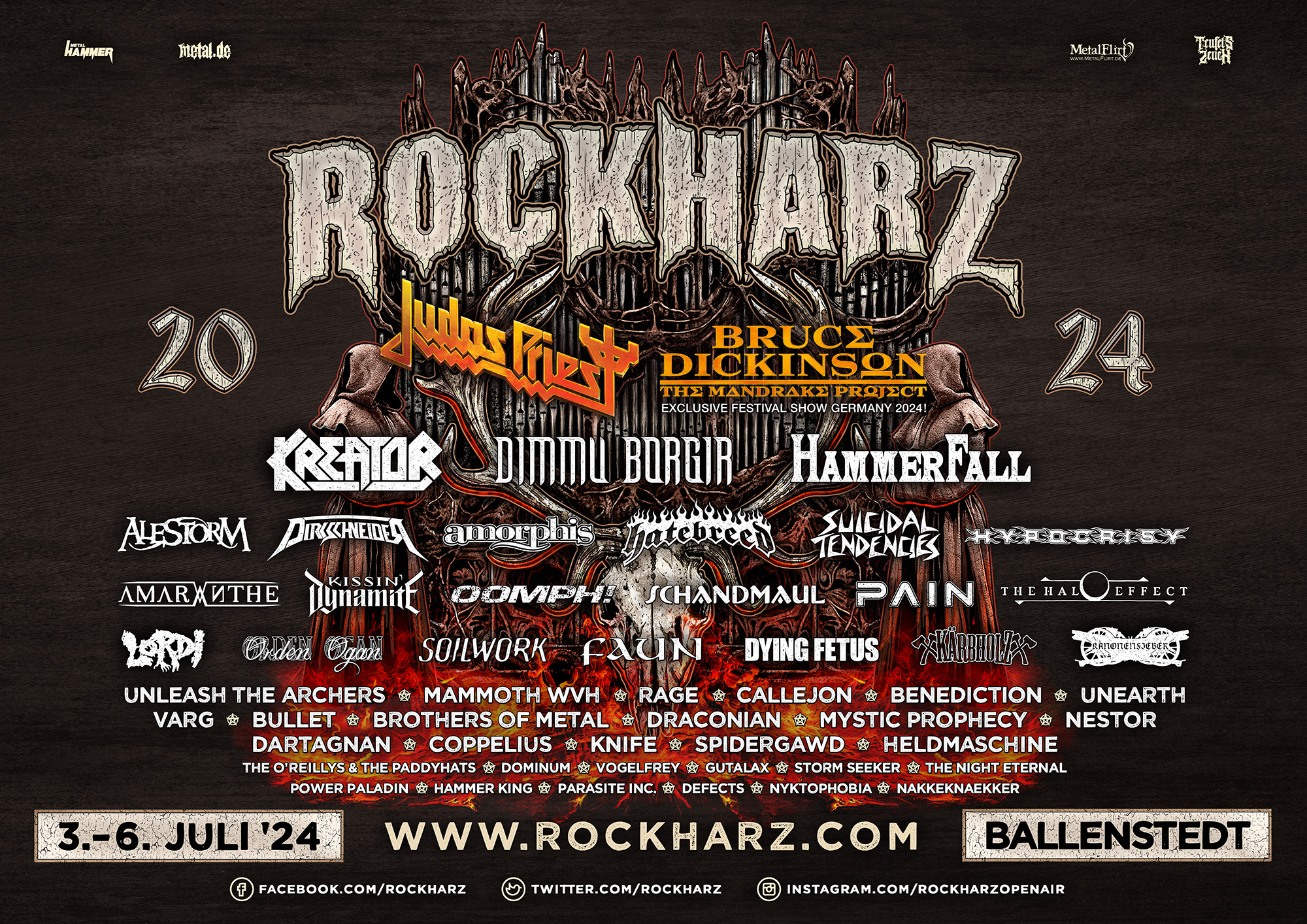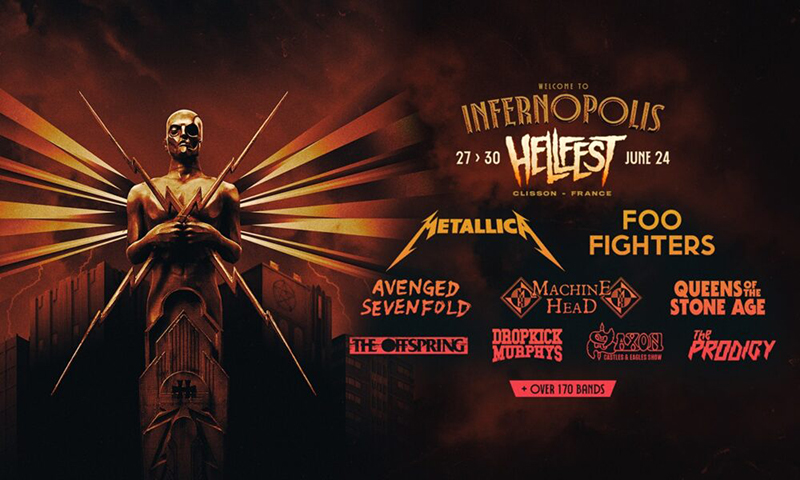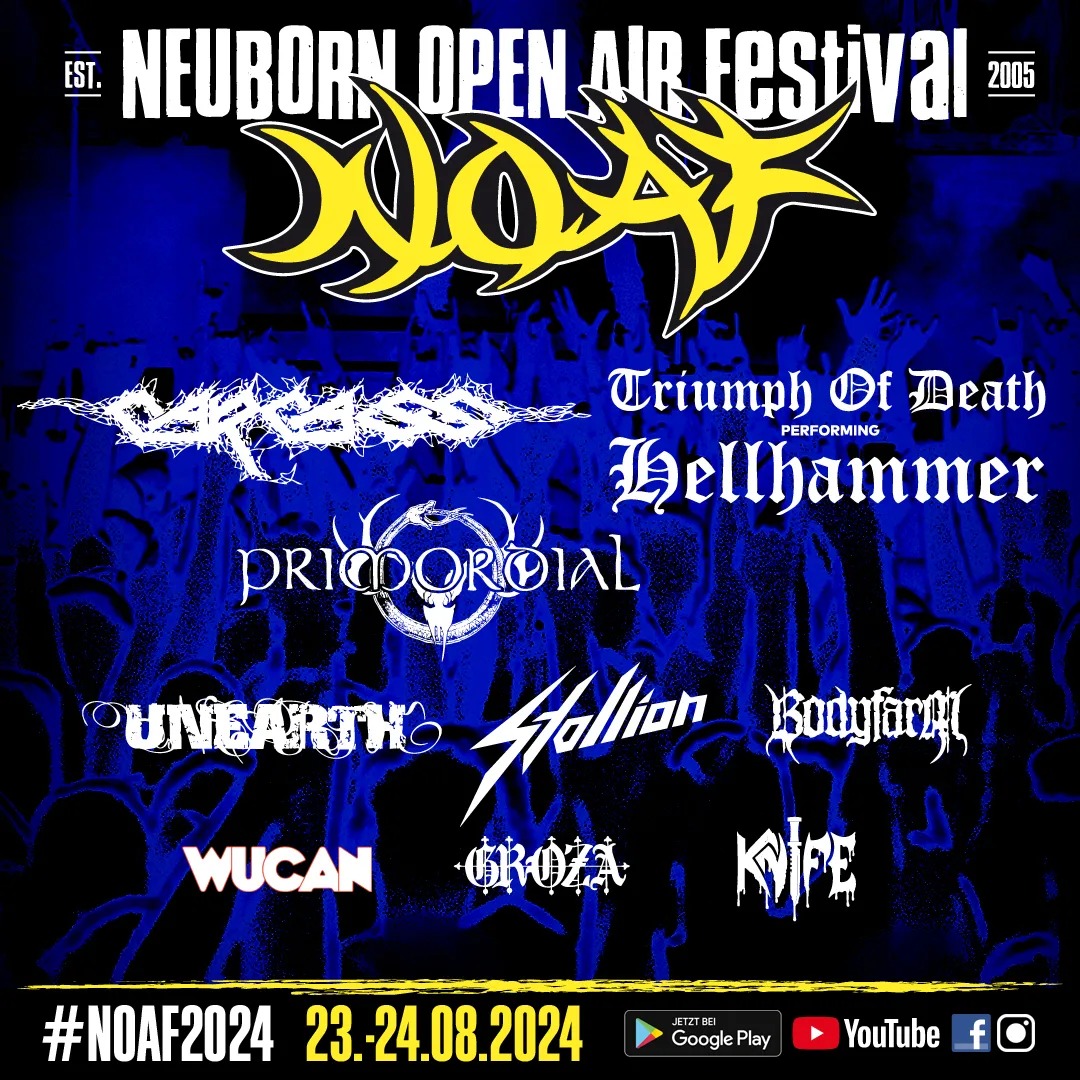Als Green Lung im Juni den Nachfolger ihres bombastischen Debütalbums „Woodland Rites“ ankündigen, fackel ich nicht lange und bestelle mir die „Black Harvest“-Vinyl via Bandcamp. Am nächsten Tag sehe ich, dass die Band auch neuen Merch auf ihrer Website hat. Da ich mir das doppelte Porto sparen will, schreibe ich sie auf Bandcamp an, um meine Bestellung zu canceln und bekomme Antwort von einem Tom.
Tom? Tom Templar, der Sänger der Band? Die Band, die Interviews mit dem Guardian führt und kürzlich einen Major-Deal abgelehnt hat, um beim finnischen Indie-Label Svart Records anzuheuern, managt Plattenversand und Mailkonversation mit Kunden auf Bandcamp selbst? Sympathisch!
Er ist es tatsächlich. Ich frage, ob er Bock auf ein Interview hat und nach ein paar Wochen treffen wir uns virtuell und quatschen knapp eine Stunde über die Entstehung des neuen Albums, kulturelle Einflüsse und unsere jüngsten Konzerterlebnisse. Was folgt, ist eine gekürzte Version unseres Gesprächs.
Interview von Marius Göddert | Jump to the English version of the interview

© Green Lung
HF: Hi Tom, für die meisten Bands bedeutete die Pandemie, dass Shows abgesagt wurden und sie ins Studio gingen, um neues Material aufzunehmen. Wie war das für euch? War das Songwriting für „Black Harvest“ größtenteils abgeschlossen als die Pandemie kam, oder habt ihr die Zwangspause genutzt, um neue Songs zu schreiben?
Tom: Direkt nachdem „Woodland Rites“ rauskam, hatten wir ein paar Songs geschrieben. Anfang 2019 hatten wir „Leaders of the Blind“ und „Old Gods“. Und dann gibt es da noch einen Song namens „Reaper’s Scythe“, den wir gerade [als Single] veröffentlicht haben, der tatsächlich auf „Free the Witch“ [erste EP] zurückgeht und ursprünglich „Let the Devil In“ hieß [jetzt ein Song auf „Woodland Rites“]. Und dann landeten die Texte in dem anderen Song. Dann ging Scott [Gitarrist] in den Songwriting-Modus und schrieb den Großteil des Albums in etwa zwei oder drei Monaten. Ich würde sagen, Ende 2019 hatten wir den Großteil des Albums, vielleicht acht Songs.
Aber dann ist unser Bassist ausgestiegen. Ich denke, das Album wäre schneller gekommen, wenn das nicht passiert wäre. Das hat uns wirklich sechs Monate außer Gefecht gesetzt, weil wir nicht üben konnten. Anfang 2020 war es ziemlich hart: Wir mussten alle Shows absagen, wir hatten gerade unseren Bassisten verloren, wir hatten wie den größten Teil des neuen Albums geschrieben, konnten uns aber nicht treffen und dann kam der Lockdown. Ich habe die meisten Texte im ersten Lockdown geschrieben. Joe, der neue Bassist, kam im März dieses Jahres an Bord.
Am Ende des Jahres haben wir drei Monate geprobt und sind Ende November ins Studio gegangen. Wir haben uns zwei Wochen Zeit genommen und mitten in einem weiteren Lockdown im Studio gewohnt und aufgenommen. Es hat sich also schon verzögert, aber „Woodland Rites“ ist jetzt zwei Jahre her und es ist nicht so, als hätten uns alle vergessen. Und eigentlich ist es auch aufregend, weil ich froh bin, dass diese Lockdowns auch etwas positives hervorgebracht haben.
HF: Wahrscheinlich war der Lockdown auch eine gute Inspiration für düstere Songtexte, oder?
Tom: Ja, auf jeden Fall. Wenn ich auf das Album zurückblicke, sind die Texte auf jeden Fall angepisster als auf „Woodland Rites“. Und das spiegelt wahrscheinlich wider, was wir alle in den letzten 18 Monaten durchgemacht haben. Ich glaube in den nächsten Jahren werden einige angepisste Alben rauskommen.

© Green Lung: Woodland Rites
HF: Die Texte auf „Woodland Rites“ waren sehr von Folklore, Hexerei, Heidentum und Horrorfilmen beeinflusst. Habt ihr den Einfluss auf „Black Harvest” beibehalten? Was ist deine persönliche Verbindung zu den Themen?
Tom: Als wir Green Lung gegründet haben, wollte ich, dass es etwas sehr Britisches wird. Es gibt viele Stoner Rock-Bands in Großbritannien, die über Area 51 und die Wüste singen. Wir haben aber keine Wüsten in Großbritannien. Ich finde englische Folklore faszinierend. Ich bin kein Heide, ich bin totaler Agnostiker. Wir sind als Band ziemlich anti-religiös.
Wir haben mit diesem Natur- und Folklorethema für den Song „Green Man Rising“ angefangen und Folklore als Metapher für die Natur verwendet. Ich denke, das wird immer ein Teil davon sein. Rückblickend hatte „Woodland Rites“ ein Frühlingsgefühl. Das war nicht mal beabsichtigt, aber das Thema Frühling passte wunderbar zu dem Album. Und bei „Black Harvest“ geht es um die Erntezeit. Es ist weniger im Wald, es ist eher in den Feldern. Das Jahr neigt sich dem Ende zu. Ich denke, Ernte als Thema ist ein reichhaltiges Thema für sowas.
Aber es gibt einen bluesigen Song über den Klimawandel oder einen echten Hammer Horror Popsong über den Film Dracula AD 1972. „Woodland Rites“ hat den Leuten gefallen, weil es sich sehr stimmig angefühlt hat, fast wie ein Konzeptalbum. Das passiert bei mir beim Schreiben fast auf natürliche Art. Wir schreiben Alben, wir schreiben keine Singles. Wir betrachten jeden Song als Teil eines Albums, also müssen auch die Texte mitgehen. Das neue Album ist definitiv erbaulich, aber auch wütender und apokalyptischer. Mein Plan ist, auch ein Sommeralbum und ein Winteralbum zu schreiben. Vier Alben, die jeweils einer anderen Jahreszeit gewidmet sind.
HF: Hast du eine persönliche Lieblingsstory aus dem Folk Horror Genre, die du empfehlen könntest?
Tom: Es gibt einen Fantasy-Roman aus den 80ern namens “Mythago Wood” von Robert Holdstock. Es geht um einen Soldaten, der aus dem 2. Weltkrieg zurückkehrt und auf die Farm der Familie zieht und bemerkt, dass mit dem nahegelegenen Wald offensichtlich irgendetwas nicht stimmt. Jedes Mal, wenn er reingeht, scheint der Wald größer zu werden. Und da sieht er alle möglichen folkloristischen Charaktere im Wald und es ist alles ziemlich psychedelisch und seltsam. Je weiter er in den Wald vordringt, desto weiter geht er zurück in die britische Fantasiewelt.
Es ist ein wirklich psychedelischer Roman und ich denke, es ist das krasseste Green-Lung-mäßige Buch, weil wir irgendwie genau das mit Musik versuchen. Green Lung ist eigentlich eine witzige Sache, weil wir alle vor Green Lung in viel härteren Bands waren als Green Lung. Und das ist wie unsere Popband. Und ich denke, das Underground-Zeug ist immer noch drin, obwohl es viel zugänglichere Musik ist.

© Green Lung
HF: Mir kommt es oft so vor, als würdet ihr fette Hardrock- und Blues-Riffs schreiben und schon allein durch die tiefgestimmten Gitarren wird es zu etwas völlig Neuem.
Tom: Ja, Scott schreibt im Grunde große Hardrock-Songs. Die Art und Weise wie wir das machen, macht es dann interessant. Und man kommt mit vielen Sachen durch, mit denen man in Doom nicht durchkommen würde, nur durch die richtige Atmosphäre, die richtige Härte und verdammt brutale Riffs. Wir schreiben gerade Sachen, in die wir sowas wie einen Hardcore-Beatdown packen. Sogar in Lady Lucifer, einem unserer ersten Songs, gibt es einen ganzen mittleren Achter-Takt, der nach total nach Madball klingt. Aber niemand hat diesen Eindruck. Niemand wird denken, dass es wie Madball klingt. Jeder wird es sich anhören und denken, es klingt wie Black Sabbath, was es eigentlich nicht tut.
HF: Und ihr habt diesen derben Bass, der ordentlich treibt.
Tom: Ja, der Bass war immer sehr dominant. Auf dem neuen Album ist es interessant, weil John, der Keyboarder, einfach ein zentralerer Teil der Band ist. Wir haben einige Momente, wo das Keyboard eine Deep Purple-Atmosphäre reinbringt. Aber es war interessant, das Keyboard mit dem Bass auszubalancieren, weil wir den Bass vorher immer so weit nach oben gestellt haben. Und ich glaube, wir haben es hinbekommen. Ich finde es klingt echt cool. Es klingt verdammt heavy. Keyboards können echt heavy sein. Niemand hält Keyboards für ein heavy Instrument. Aber wenn Sie du so einen dröhnenden Hammond-Vibe hast, kann dir das auch auf die Schnauze geben. Es gibt einige Riffs auf dem neuen Album, die einfach brutal sind, weil sie Bass, Gitarre und Keyboard vereinen. Zum Beispiel das auf „Upon the Altar“ – wahrscheinlich einer meiner Lieblingssongs. Und das funktioniert einfach gut.
HF: Ich habe gelesen, ihr habt den Gesang von „The Harrowing“ in einer Kirche aufgenommen, in die ihr eingebrochen seid. Kannst du dazu etwas sagen?
Tom: Es gab bei diesem Album einen großen Unterschied: Wir haben „Woodland Rites“ in etwa vier Tagen in einem sehr kleinen Studio aufgenommen, das unserem Produzent Wayne Adams gehört. Es war toll, wir haben es geliebt, aber es war ein winziges Studio in London. Für das neue Album hat er uns vorgeschlagen, nach Wales zu gehen. Also haben wir uns zwei Wochen Zeit genommen und im Dezember aufgenommen. Das Studio war in einem Bauernhaus auf einem Hügel, und am Fuße des Hügels war dieses winzige Dorf. Es war ziemlich neblig und frostig, weil es Dezember war. Wir sind runter ins Dorf gegangen und haben nachgesehen, ob die Kirche offen ist und das war sie. Also sind wir einfach reingegangen. Da war eine alte Orgel und ein tolles Ambiente, wenn man da drin gesungen hat. Also haben wir einfach ein paar Mikros aufgestellt. Wir hatten die Idee, dass das Intro zum Album wie ein Sample klingen sollte, das nur ich singe. Und ich dachte: “Wir sollten es hier tun.”
Das Albumcover, die Glasmalerei, die ganze Kirchensache war auch eine Hommage an dieses Erlebnis. Der Ort, wo wir aufgenommen haben, hatte definitiv einen Einfluss auf das Album, den ich nicht unbedingt erwartet hatte. Es ist schon erstaunlich, wie sehr es inspiriert, an einem Ort zu sein. Wir haben ein seltsames Saiteninstrument im Keller des Studios gefunden und es sogar für einen der Songs benutzten, nur um diese Art von Folk-Horror-Intro zu machen. Es hatte einen starken Einfluss auf das Album, wo wir es aufgenommen haben.

© Green Lung: Black Harvest
HF: Richard Wells hat mit dem Cover-Artwork wieder ganze Arbeit geleistet. Wie genau waren eure Vorgaben, oder habt ihr ihm eine Idee gegeben und ihn einfach machen lassen?
Tom: Es war unsere Idee. Bei „Woodland Rites“ hat er einen tollen Job gemacht. Er hatte noch nie zuvor ein Albumcover designt. Er mag nicht einmal Heavy Metal, er liebt einfach Horrorfilme. Aber das finde ich gut. Dadurch sieht es für mich nicht aus wie derselbe alte Kram.
Für das erste Album hatten wir Holzschnitte gemacht. Uns gefiel hier die Idee von Glasmalereien als eine andere mittelalterliche Kunstform, die für religiöse Zwecke gemacht wurde. Und ich glaube, der Ziegenbock ist sozusagen unser Eddie geworden. Ich mag die Idee, diesen Goat Wizard auf jedem Albumcover zu haben.
HF: Zu guter Letzt, was war die letzte Band, die du live gesehen hast und wann war das?
Tom: Das war letztes Wochenende [Anm.: 7. August]. Ich hatte ein kostenloses Ticket für ein Open Air bei mir um die Ecke. Die Band war Fat White Family, eine Art Indie Band. Ich bin kein Riesenfan von der Musik gewesen, aber es war nett sich in der Sonne im Park zu betrinken.
GREEN LUNG: „WE WRITE ALBUMS, WE DON’T WRITE SINGLES”
When Green Lung announced the successor of their bombastic debut record “Woodland Rites” in June, I didn’t hesitate and instantly ordered the “Black Harvest” vinyl via Bandcamp. The next day I noticed new merchandise on the band’s own website. I didn’t want to pay double shipping and wrote to their Bandcamp account to cancel my order of the previous day. I got an answer from Tom.
Tom? Tom Templar, the singer of the band? The band that recently was interviewed by The Guardian and turned down a major label deal to get signed by the Finnish indie label Svart Records manages record shipments and mail conversation with customers on Bandcamp? That sounds nice.
It’s him actually. I ask if he is down for an interview and after a few weeks we meet online for roughly an hour and talk about the making of the new album, cultural influences, and our latest concert experiences. Below you can read a shortened version of our conversation.
Interview by Marius Göddert

© Green Lung
HF: Hi Tom, to many bands, the pandemic meant a cancellation of all shows and prompted them to go into the studio and record new material. How was it for you? Was the songwriting for “Black Harvest” mostly done by the time the pandemic struck or did you use the obligatory hiatus to come up with new stuff?
Tom: Immediately after “Woodland Rites” came out, we had a couple of songs written. We had “Leaders of the Blind” and a song called “Old Gods”. And then there’s a song called “Reaper’s Scythe” we just released [as a single], which actually dates back to “Free the Witch” [first EP] and was originally called “Let the Devil In” [now a song on “Woodland Rites”]. And then the lyrics ended up on the other song. And then Scott [guitarist] went into songwriting mode as he does and wrote the majority of the album in about two or three months. I’d say by the end of 2019 we had the majority of the album, maybe like eight songs.
But then our bassist left. I think the album would have come quicker if that hadn’t happened. That really took us out of action for six months because we couldn’t practice. It was pretty rough at the beginning of 2020 because we had all these shows cancelled, we just lost our bassist, we had like most of the new album written but hadn’t come together and then lockdown struck. I wrote the majority of lyrics I’d say in the first lockdown. Joe who is the new bassist came aboard in March that year.
So that by the end of the year, we’d been practicing for three months and went into the studio in late November and just did a sort of residential two weeks in the middle of like another lockdown. So it’s like, it’s been delayed but I think it’s actually two years on from “Woodland Rites”, it’s not like everyone has forgotten about us. And actually, it’s kind of exciting because I’m glad something came of all of that time sort of just stuck indoors really.
HF: Probably the lockdown also served as a good inspiration for an atmosphere to write sinister lyrics, right?
Tom: Yeah, I think definitely, I was thinking about looking back on this record the lyrics are way more pissed off than on Woodland Rites. And that’s probably the sense of what we’ve all been through in the past 18 months. I think there’s gonna be a lot pissed of albums dropping in the next few years.

© Green Lung: Woodland Rites
HF: The lyrics on “Woodland Rites” were heavily influenced by folklore, witchcraft, paganism, and horror movies. Does that influence also show on “Black Harvest” and what is your personal connection to these themes?
Tom: When we started Green Lung I wanted it to be something very British. You know, there’s a lot of Stoner Rock bands in the UK who do sing about Area 51 and the desert. You know, we don’t have deserts in the UK. I think English folklore is fascinating. You know I’m not a Pagan, I’m total agnostic. We are pretty anti-religion as a band.
We started off with this nature and folklore theme, which for a song was called “Green Man Rising”, which was using folklore as a metaphor for nature. I think that’s always gonna be part of it. On “Woodland Rites”, looking back, it had a Springtime feeling the whole album. And it’s interesting because that wasn’t intentional but the theme of Spring suited that album beautifully. And with “Black Harvest” the idea was to move on to harvest time. It’s less out in the forest, it’s more in the fields. The year is closing in. I think harvest as a theme is really rich for that stuff.
But also there’s some stuff like a bluesy song about climate change, there is a real hammer horror pop song about the movie Dracula AD 1972. With “Woodland Rites”, the reason people liked it, is because it felt very coherent. It felt almost like a concept album, and I think that is something very natural to how I write. We write albums, we don’t write singles. We think of each song as part of an album, so the lyrics have to walk with that as well. The new album is definitely uplifting but it’s definitely more angry and apocalyptic. My plan is to also write a summer album and a winter album as well. Do four albums which each correspond with a different season.
HF: Do you have a personal favorite folk horror story that you would recommend?
Tom: There’s a novel called ‘Mythago Wood’ by Robert Holdstock which is an 80’s Fantasy Novel. It is about a soldier who is returning from World War 2 and moves to the family farm and there is obviously something strange going on with the wood nearby. Every time he walks into it, it seems to grow bigger as he walks in. And there are all sorts of folkloric characters he sees in the wood and it’s all quite psychedelic and strange. The further he goes into the wood, the further he goes back into British imagination.
It’s a really psychedelic novel and I think it’s the most Green Lung fucking book because that’s kinda what we are trying to do with music. Green Lung is a funny thing because we all were in much more extreme bands than Green Lung, before Green Lung. And this is like our pop band. And I think the underground stuff is still in there even though it’s much more accessible music.

© Green Lung
HF: To me, it often seems like, you write the fat hard rock and bluesy riffs, and already just by tuning the guitars down so far, it becomes something totally new.
Tom: Yeah you know, Scott basically writes big hard rock songs. It’s how we do it that’s interesting. And you get away with a lot of stuff you wouldn’t be able to get away with in Doom just by the right atmosphere, the right heaviness, having fucking brutal riffs. There’s stuff we are writing at the moment and we’re putting in a hardcore beatdown almost. Even in Lady Lucifer, which is one of our first songs, there is a whole middle eight-bar which sounds like something that Madball would do, but no one thinks of it like that. No ones is going to think that it sounds like Madball. Everyone is going to listen to it and think it sounds like Black Sabbath, which it doesn’t actually.
HF: And you’ve got that mighty bass that really serves as a driver.
Tom: Yeah, the bass was always really upfront. On the new album it’s interesting because John, the keyboarder is just much more a part of the band. We have some Deep Purple moments where the keys add notes of atmosphere. But it was interesting balancing the keys with the bass because we put the bass so far up. And I think we got it right actually. I think it sounds really cool. It sounds fucking heavy as hell. Because I think keys can be really fucking heavy. Noone thinks of them as a heavy instrument. But if you got that roaring Hammond vibe, it really punches you in the face. There are some riffs on the album, for example, the one on “Upon the Altar” – which is probably one of my favorite songs we’ve got on it – which is absolutely brutal, because it’s full bass, guitar, and keys. And it just works well.
HF: I read that you recorded the opening vocal of “The Harrowing” in a local church that you broke in. What was that about?
Tom: So there was one big difference this time: We recorded “Woodland Rites” in about four days in a very small studio, which is owned by our produced Wayne Adams. It was great, we loved it but it was a tiny studio in London. And he’s suggested we should go to Wales and do some residential. So we took two weeks out and recorded in December. So this is like a farmhouse studio on top of a hill, and then at the bottom of the hill was this tiny village. And it was pretty misty and frosty because it was December. We went down to the village and tried the door of the church and it was open. So we just went in and there was an old pipe organ and there was this amazing ambiance when you were singing in there. So we just set up some contact mics. We had this intro to the album that was always gonna sound like a sample just me singing. And I was like: “We should do it here.”
The album art, the whole stained glass thing, the whole church thing was also a tribute to that as well. Where we recorded definitely had an effect on the album which I wasn’t necessarily expecting. It’s kinda amazing how much being in a place inspires. We found a weird stringed instrument on the bottom of the basement of the studio and even used that on one of the songs just to make this sort of folk horror intro. It had a massive effect on the album where we recorded it.

© Green Lung: Black Harvest
HF: Richard Wells, again, did a great job with the cover artwork. Were you very specific with what you wanted on the cover or did you tell him an overall theme and let him do whatever he wanted?
Tom: We came up with the idea. With “Woodland Rites” he did such a great job. He had never illustrated an album before that. He doesn’t even like heavy metal, he just loves horror films. But I think that’s good. I think that makes it more distinct. It doesn’t to me look like the same old same old.
When we had done woodcuts for the first album and we kinda liked the idea of stained glasses as another medieval art form that was made for religious purposes. And I think goaty guy has become sort of our Eddie. I like the idea to have that goat wizard guy on every album in some way.
HF: Last but not least, what was the last band you went to see live and when was that?
Tom: Last weekend [August 7], just down the road I had a free ticket to an open-air, which was fun. The band was Fat White Family, an indie sort of band. I wasn’t a huge fan of the music but it was just nice to be out in a park getting drunk in the sun.

